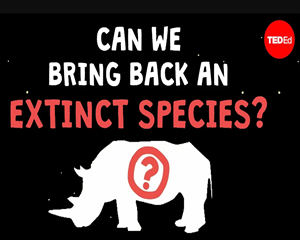In the savannahs of Kenya, two female northern white rhinos, Nájin and Fatu, munch contentedly on the grass.
在肯尼亚的大草原上,两头雌性北部白犀牛,纳金和法图,正在草地上大快朵颐。
At the time of this video's publication, these are the last two known northern white rhinos left on Earth.
在这段视频发布的时候,它们是已知地球上仅存的最后两头北部白犀牛。
Their species is functionally extinct -- without a male, Nájin and Fatu can't reproduce.
这一物种在功能上已经灭绝了,没有雄性个体的存在,纳金和法图根本无法繁衍。
And yet, there's still hope to revive the northern white rhino. How can that be?
但是,复兴北部白犀牛这一物种的希望还存在。要如何做到呢?
The story starts about 50 years ago, when poachers began illegally hunting thousands of rhinos across Africa for their horns.
这个故事始于大约50年前,当时的偷猎者在非洲各地开始非法狩猎,捕获了数以千计的犀牛。
This, combined with civil wars in their territory, decimated northern white rhino populations.
再加上它们的领土上发生了内战,导致北部白犀牛的数量锐减。
Concerned conservationists began trying to breed them in captivity in the 1970s, collecting and storing semen from males.
20世纪70年代,环保人士开始尝试人工饲养这些犀牛,并收集和储存雄性犀牛的精液。
Only four rhinos were ultimately born through the ambitious breeding program. Nájin, and her daughter Fatu were the last two.
尽管存在这项雄心勃勃的繁衍计划,最终也只诞生了四头犀牛。纳金和女儿法图是最后两头。
In 2014, conservationists discovered that neither can have a calf.
2014年,环保主义者发现,这两头犀牛都无法生育下一代。
Though Nájin gave birth to Fatu, she now has weak hindlegs, which could harm her health if she became pregnant again.
虽然纳金生了法图,但现在它的后腿很脆弱,如果她再次怀孕,可能会危害她的健康。
Fatu, meanwhile, has a degenerated uterine lining. Then, the last northern white rhino male of the species, Sudan, died in 2018.
同时,法图则出现了子宫内膜退化。随后,最后一头雄性北方白犀牛,苏丹,也于2018年死亡。
But there was one glimmer of hope: artificial reproduction.
但是还有一线希望:人工繁殖。
With no living males and no females able to carry a pregnancy, this is a complicated and risky process to say the least.
没有存世的雄性白犀牛,也没有能够怀孕的雌性白犀牛,这至少也是一个复杂而冒险的过程。
Though scientists had stored semen, they would have to collect the eggs -- a complex procedure that requires a female to be sedated for up to two hours.
尽管科学家们储存了精液,还不得不收集卵子--这一复杂的过程需要给雌性白犀牛注射效力长达两小时的镇静剂。
Then, they'd create a viable embryo in the lab -- something that had never been done before, and no one knew how to do.
然后,他们还需要在实验室里创造出具备可存活的胚胎,这是一次前无古人的尝试,没人知道怎样才能成功。
Even that was just the beginning -- a surrogate mother of another rhino species would have to carry the embryo to term.
就连这一步也仅仅是开始--另一个代孕犀牛物种还必须孕育胚胎至足月。
Females of a closely related species, the southern white rhino, became both the key to developing a rhino embryo in a lab and the leading candidates for surrogate mothers.
南方白犀牛是北方白犀牛的近亲物种,于是雌性白犀牛成为了实验室犀牛胚胎发育的关键,也是代孕母体的首选对象。
Northern and southern white rhinos diverged about a million of years ago into separate -- though still closely-related -- species.
大约在一百万年前,南北白犀牛就分化成了彼此独立,但仍具备亲缘关系的物种。
They inhabit different regions, and have slightly different physical traits.
它们栖居在不同的地区,并拥有略微不同的物理特征。

In a fortunate coincidence, several female southern white rhinos needed treatment for their own reproductive problems, and researchers could collect eggs as part of that treatment.
在一个机缘巧合下,几头雌性南方白犀牛刚好出现了生殖问题,让研究人员得以收集卵子作为治疗的一部分。
In Dvur Králové Zoo in October 2015, experts of IZW Berlin began collecting eggs from southern white rhinos and sending them to Avantea, an animal reproduction laboratory in Italy.
2015年10月,在德武尔·克拉洛维动物园,来自德国莱布尼兹动物园与野生动物研究所的专家开始收集南部白犀牛的卵,并把它们送到了意大利的阿凡提亚动物繁殖实验室。
There, scientists developed and perfected a technique to create a viable embryo.
在那里,科学家发展和完善了一项能创造可存活胚胎的技术。
Once they mastered the technique, researchers extracted Nájin and Fatu's eggs on August 22, 2019 and flew them to Italy.
在掌握了这项技术之后,在2019年8月22日,研究人员提取了纳金和法图的卵子,并把它们送到了意大利。
Three days later, they fertilized the eggs with sperm from a northern white rhino male.
三天后,他们用一头雄性北方白犀牛的精子使卵子受精。
After another week, two of the eggs made it to the stage of development when the embryo can be frozen and preserved for future.
又过了一周,两颗卵子进入了发育阶段,这时就可以对胚胎进行冷冻保存以备用。
Another collection in December 2019 produced one more embryo.
在2019年12月搜集的精子和卵子又生产了一颗新的胚胎。
As of early 2020, the plan is to collect Nájin and Fatu's eggs three times a year if they're healthy enough.
到2020年初,研究人员计划在保证纳金和法图身体健康的情况下,每年收集三次它们的卵子。
In the meantime, researchers are looking for promising southern white rhino surrogate mothers -- ideally who've carried a pregnancy to term before.
同时,研究人员也在寻找潜在的南部白犀牛代孕母体--最理想的是有过足月生育经历的母体。
The surrogacy plan is somewhat of a leap of faith -- southern and northern white rhinos have interbred both during the last glacial period and more recently in 1977,
这一代孕计划在某种程度上是信仰的一次飞跃,南部和北部白犀牛都是在上一个冰河时期和最近的1977年才进行杂交的,
so researchers are optimistic a southern white rhino would be able to carry a northern white rhino to term.
所以研究人员对南部白犀牛能够孕育北部白犀牛的胚胎至足月持非常乐观的态度。
Also, the two species' pregnancies are the same length. Still, transferring an embryo to a rhino is tricky because of the shape of the cervix.
另外,这两个物种的孕期相同。尽管如此,由于子宫颈的形状的差异,犀牛胚胎跨物种移植依然是一个非常复杂的过程。
The ultimate goal, which will take decades, is to establish a breeding population of northern white rhinos in their original range.
最终目标是在数十年的时间内将北方白犀牛的繁殖数量恢复到最初的水平。
Studies suggest that we have samples from enough individuals to recreate a population with the genetic diversity the species had a century ago.
研究表明,我们拥有的个体样本数量足以重现一个世纪前该物种拥有的遗传多样性种群。
Though the specifics of this effort are unique, as more species face critical endangerment or functional extinction, it's also an arena for big questions:
虽然这项工作具有其独特性,但随着更多物种濒临灭绝或功能性绝种,也引出了一些不容忽视的问题:
do we have a responsibility to try to bring species back from the brink, especially when human actions brought them there in the first place?
我们是否有责任尝试挽救由于人类行为而导致濒危的物种?
Are there limits to the effort we should expend on saving animals threatened with extinction?
我们为拯救濒危动物所付出的努力有上限吗?













